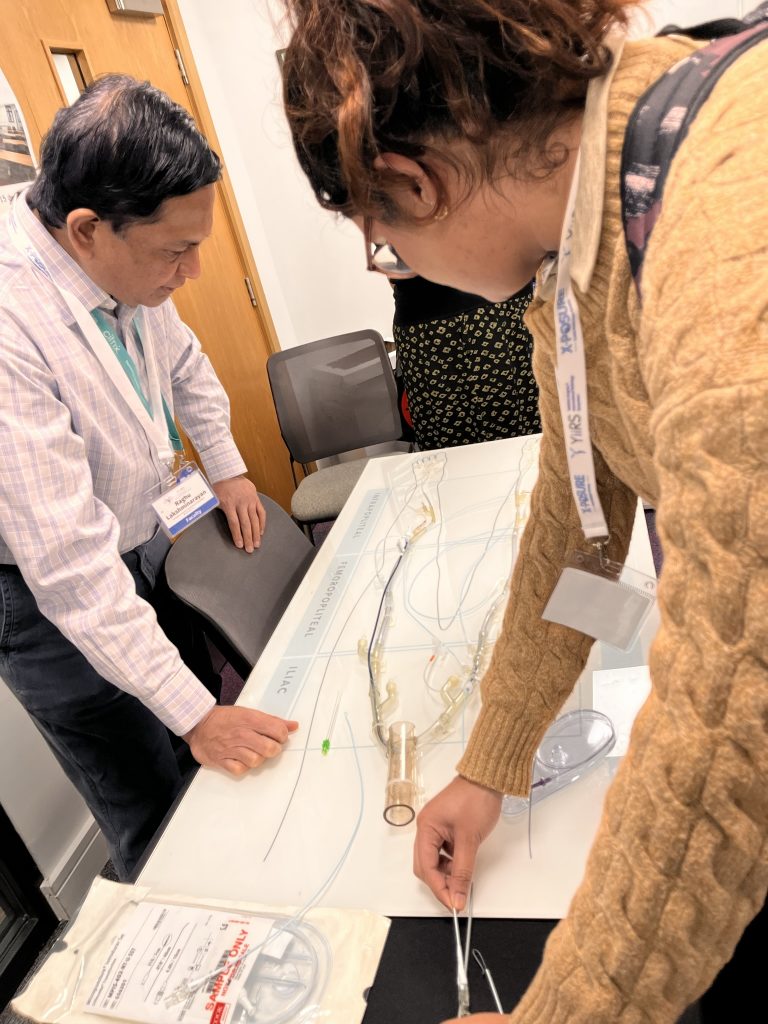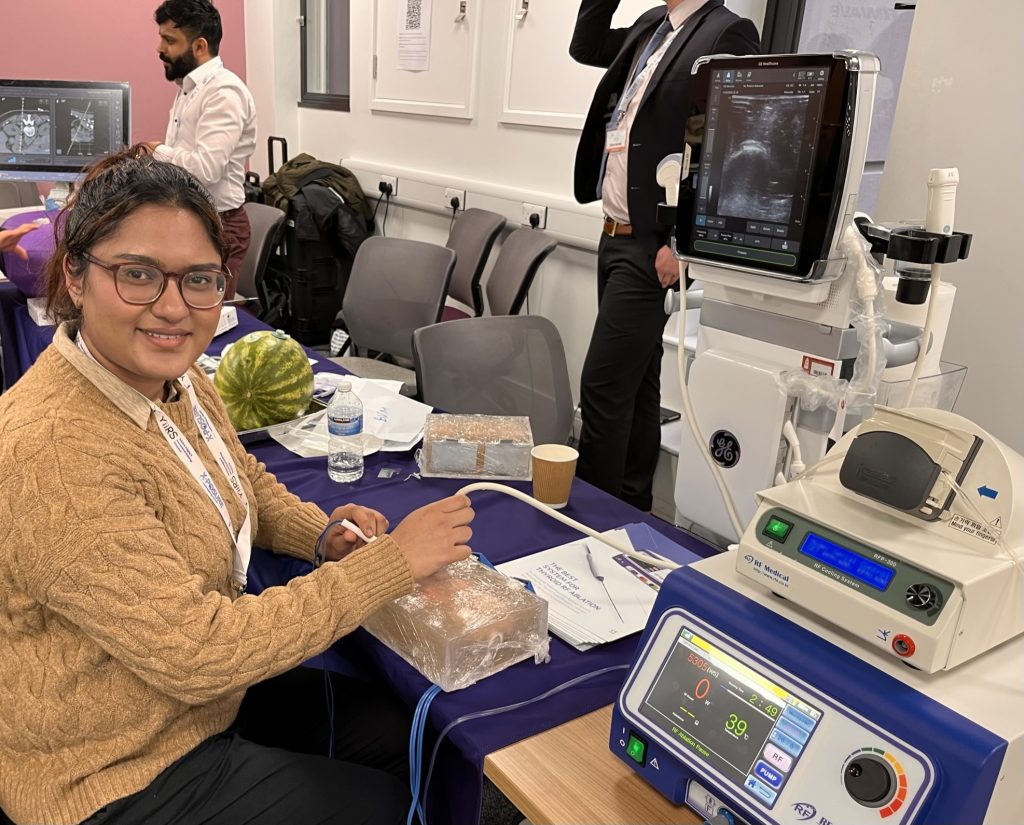On Saturday 11th of February 2023, I attended the Yorkshire Imaging and Interventional Radiology Symposium (YIIRS), held in the Worsley Building at the University of Leeds. The university’s radiology society, X-Posure, had a brilliant and busy day in store for delegates. I was excited to learn more about a field of medicine I am interested in, albeit knew little about. The event was free of charge both online and in-person. However, the in-person session came along with the added advantages of attending workshops led by world-class physicians and, crucially, free lunch!
My interest in diagnostic radiology began when I attended respiratory clinics in my third year of medical school where I saw how X-rays, CT and PET scans can be used to identify and manage lung pathology. Interventional radiology (IR), in addition to imaging, offers patients minimally invasive procedures such as nephrostomies and angioplasties. As well as learning about interesting cases and expanding my knowledge, the conference shed light on the day-to-day challenges interventional radiologists face. These are some of my highlights of the day.
We were warmly welcomed by Professor Tze Min Wah (the chair of YIIRS and a senior consultant radiologist in diagnostic and IR) to a series of talks by interventional radiologists who passionately spoke about their respective subspecialties ranging from trauma to paediatrics. Starting off the talks was Dr Costa Tingerides who specialises in delivering vascular interventions at Leeds Teaching Hospitals. He discussed how trauma is the leading cause of death in the under 45 year old population and how IR has improved trauma care in recent years through developments such as Resuscitative Endovascular Balloon Occlusion of the Aorta (REBOA) which works by temporarily halting major bleeding from an injury. It does this by deploying a small balloon intravascularly which is inflated when it reaches the aorta. It has many other applications in various departments such as emergency medicine and obstetrics. Another technique Dr Tingerides highlighted was embolisation, for example in splenic lacerations from bicycle handlebar trauma. This works by delivering embolic material via catheters to stop a haemorrhage. Vascular intervention can also be beneficial in musculoskeletal conditions. Dr Aiden O’Grady described his recent research on genicular artery embolisation which may help treat osteoarthritis of the knee. This was a particularly interesting talk as genicular artery embolisation is a relatively novel treatment method.
This was followed by a talk from Dr Nasim Tahir, a paediatric radiologist. Dr Tahir justified the importance of working as a team, and how difficult cases can be managed when collaborating with other specialities. He talked about a case where a patient presented with a large mass compressing the heart and affecting its ability to pump. He wanted to take an ultrasound-guided biopsy and find out what tissue the mass was made up of which would dictate the treatment that the patient could be given. To do this, he worked with the anaesthetist who temporarily collapsed one of the patient’s lungs so the mass would be easier to access. He further illustrated the amount of expertise needed in such cases from the anaesthetist, cardiologist, cardiothoracic surgeon and pathologist to name a few.
Adding to this, Dr Saira Sayeed, a consultant vascular radiologist at Hull University Teaching Hospitals (HUTH), demonstrated the importance of a “hybrid” IR suite. A hybrid operating room combines a traditional surgical theatre with imaging equipment such as CT scanners. If the need arises to convert a minimally invasive image-guided surgery to an open procedure, it can be done efficiently in these suites by providing all the necessary equipment and staff.
Dr Christopher Clarke, a consultant radiologist working in Nottingham emphasised the importance of maintaining a good CV throughout your career. Here are a few of his top tips: have a master CV and tailor it according to the jobs you apply for; prioritise putting your strengths at the top of the document and, overall, keep your document concise.


I spent the afternoon meandering between two rooms. The smaller room hosted the IR museum which neatly displayed the vast range of tools used in IR and the history of the field. The bigger room hosted the workshops bustling with the latest advancements in medical technology. Dr Raghu Lakshminarayan (also a consultant vascular interventional radiologist at HUTH) kindly helped me to practise the Seldinger technique. This is a common method of gaining access to vessels used in IR. A hollow needle enters the desired artery or vein and a guidewire is advanced through needle lumen. Once the needle is withdrawn, a catheter can then be placed into the vessel. Although this process felt quite intricate to me, Dr Lakshminarayan assured me it gets easier with time! I also had a go at using BVM Medical’s radiofrequency ablation system. I used an ultrasound-guided needle to locate animal tissue concealed inside a block of jelly. Using a foot pedal, I could control the frequencies transmitted to ablate the tissue. In the real world, this device is useful in minimising tumours.
One of the last talks of the day was by Dr Georgia Priona (a consultant interventional radiologist). She explained the importance of increasing equality and diversity in the field. She encouraged students to embrace available opportunities and take pride in their career. This was very inspirational and I was happy to have role models such as herself and Professor Wah to look up to as a female medical student.
There is often little exposure to radiology in the undergraduate curriculum but there are other opportunities if you are interested in gaining some experience. Some key points from the speakers were to get involved early, talk to consultants within your radiology department and introduce yourself to the team, and get involved in medical school by being part of or creating your own radiology society! You can attend conferences such as these (that run throughout the country) or read more on online resources such as IR Juniors or Dr Clarke’s own website Radiology Cafe.
Thanks to X-Posure Leeds for organising such a fantastic event and to the speakers for their illuminating talks and workshops.
~~~~~~~~~~~~~~~~~~~

Tajri Salek is a fourth year medical student at the Hull York Medical School where she is currently the secretary of its radiology society. She is interested in pursuing a career in radiology and enjoys creative writing and poetry in her spare time.

